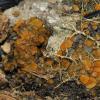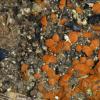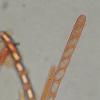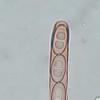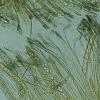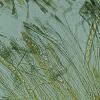
24-12-2025 17:08
Hulda Caroline HolteHello, I have found this propoloid ascomycete on

21-12-2025 09:32
Hello.A tiny ascomycete found embedded in wood in

21-12-2025 21:32
Pol DebaenstHello, Garden, Burgweg 19, Veurne, BelgiumOn 10/1

22-12-2025 23:38
Patrice TANCHAUDBonsoir, récolte sur un mur en pierre, apothéci

22-12-2025 00:47
Patrice TANCHAUDBonsoir, récolte à proximité du milieu dunaire
 Hi, I believe this asco is Aleuria aurantia but there are two characters which I have a little doubt. The size of the ascomata are pretty small (5-10mm) and more importantly, the spores lack the reticulate surface, they are just smooth. These were found on clayey calcareous soil with burnt stems of Arundo and debris.
Hi, I believe this asco is Aleuria aurantia but there are two characters which I have a little doubt. The size of the ascomata are pretty small (5-10mm) and more importantly, the spores lack the reticulate surface, they are just smooth. These were found on clayey calcareous soil with burnt stems of Arundo and debris.Micro characters:
Ascum
Ascospore release: Apical orifice without operculum
Shape: Cylindrical, slender, rounded obtuse apex, narrowing gradually towards the base which often exhibits an abrupt curviture at the base.
No. of Spores: 8
Operculum: Not observed
Tunic (Wall): Uni-tunicate
Ascum length (range): 142 - 205 µm
Ascum length (mean): 168 µm
Ascum width (range): 10 - 12 µm
Ascum width (mean): 11.1 µm
Ascum L:W ratio: 15.1
Iodine reaction (J +/J -): J -ve
Orifice: Observed, shallow.
Remarks
Spore
Spore length (range): 14.68 - 18.82 µm
Spore length (mean): 17.2 µm
Spore width (range): 7.0 - 9.3 µm
Spore width (mean): 8.5 µm
Spore Q factor (range): 1.79 - 2.19 µm
Spore Q factor (mean): 1.98
Spore shape : Fusoid-elliptical, widest at the centre with two identical rounded poles
Spore septa: Aseptate
Spore surface: Appears smooth
Oil bodies: Two, identical spherical oil bodies, located close to each other at the centre, sometimes seen with a tiny curved apiculum
Remarks: Spores arranged obliquely
Excipulum (medullary): Spherical to obtusely angular hyphae, 25-45 µm wide

Hi Stephen,
surely this is not Aleuria aurantia.
First: the apothecia have dark margins - if Aleuria, then one could think of A. cornubiensis (Melastiza chateri)
Second: the spores seem to be fully smooth, with large oil drops.
Third: you yourself write of a burnt substrate.
This makes me think of a species of Anthracobia.
Let one of the more competent persons say something about the species.
Best regards from Lothar


http://www.mycodb.fr/fiche.php?genre=Anthracobia&espece=nitida&numphoto=7&source=list&filter=&numfiche=255
According the account above, A. nitida has the same spore size (16)17-18(19) and the characteristic orangish deposits on the paraphysis apices, same as this specimen. See photo attached.
I would label this Anthrocobia nitida unless there are other species to be considered and outside the key I consulted.

there is a key to carbonicolous discomycetes by R.Dougoud here: http://ascomycete.org/en-us/taxonomy.aspx
The hairs may be very short (just 30-40 um) and they appear on your macrophoto as the brown "dots" near margin. The same is on the first photo from the link you've posted. Unfortunately, the three yellow to orange Anthracobias with ellipsoid spores are best distinguished by their hair size. Spore size overlaps a lot.
Viktorie

I jumped in for Anthrocobia p.p. within the key and I think this species is between A. nitida and A. macrocystis which are differentiated, as you said, by the length of the hair and the size of the spores. My 'smaller' spores favours A. nitida but the hairs would confirm 100%.
Thanks Viktorie
